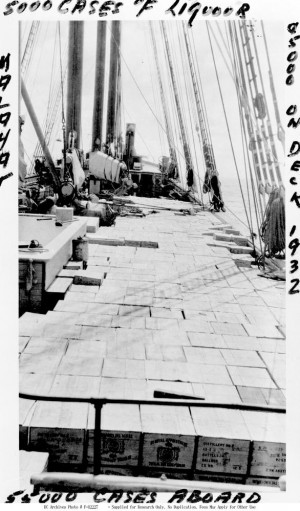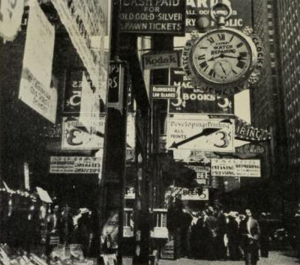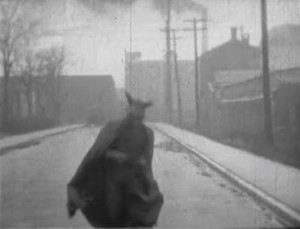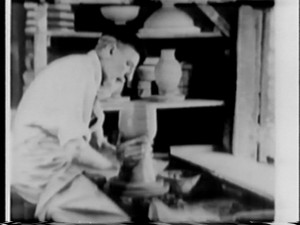
"Depicts a rum-running expedition from Victoria to "Rum Row" off the California coast with the mother ship M.V. Malahat. The tender M.V. Hickey is shown transferring cases of liquor to American vessels and avoiding US Navy cutters. At San Martin Island, Mexico, the Hickey puts in for repairs." (BC Archives)
NOTE: The original reversal film was lost in the 1990s after being sent out for video transfer in Vancouver. Only the BC Archives analog video transfer is extant.

Also known as Footnote to Fact [As I Walk].

Hell Bound Train "depicts the devil as the train's engineer both driving his locomotive toward hell and tempting the sinner-passengers that occupy various cars on the train. The film is divided into episodes each one representing a different kind of sin or sinner and set in a corresponding car of the train" Tepperman, 233-234.
"Documentario Industriale"/Industrial Documentary
"Among the ten best, Century of Progress, in Kodacolor, by Herbert H. Johnson, ACL, is a striking illustration of the degree of perfection that color motion picture photography has attained. Its studied angles and dignified composition are augmented by excellent photography. Mr. Johnson paid careful attention to the very important point of exact exposure in relation to color value and, as a result, brought a new version of the Fair to the one who had never seen it in color before. By taking plenty of time he was able to single out the best camera positions and wait for the lighting that was most favorable. The excellent handling of the camera brought a sense of intimacy to each scene. The film's only fault is an excessive use of lap dissolves which detracted somewhat from the smoothness of the continuity." Movie Makers, Dec. 1933, 499.

"Ceramics, by Kenneth V. Bloomer, ACL, and Elizabeth Sansom, ACL, is probably the most ambitious amateur film ever attempted on this particular subject and perhaps stands alone in its field. The makers of the film were fortunate in having the cooperation of a famous ceramic artist, Leon Volkmar, who maintains his atelier at Bedford Village, N. Y. It was here that the entire film was produced, its makers having imbibed the spirit of the artist craftsmen so thoroughly that every deft touch, every careful step in the process of making a lovely vase are recorded. The interior lighting and closeup technique are especially good, particularly in those parts where only the delicate focusing of a closeup will reveal the nuances of the artist's touch as he models. The sequences which show the firing of the pottery are unusually well handled and the whole is outstanding in its clarity of continuity. Such a film might be described as a "glorified industrial" but, more than that, it is an educational film in the best sense of the word." Movie Makers, Dec. 1933, 499-500.
"Pipe Dreams, by Joseph Dephoure, ACL, and Edward Atkins, ACL, is ranked among the year's ten best because of its considerable triumphs over dramatic and technical difficulties. Through the imagination of its producers, a small cast, simple settings and moderate footage have been used to tell a big story, rich in pictorial effect. Dreaming that he has murdered his unfaithful wife, a young man sees in prospect the swift and fearful course of his life to the waiting gallows. The murder, the trial, the death cell and the hanging are represented in large part only by the imaginative and striking use of shadows of the real scenes. Occasional straight shots are heightened in effect by unusual angles and dramatic lighting. Sensitively planned, smartly executed and deftly cut, Pipe Dreams makes its simple story exciting and forceful." Movie Makers, Dec. 1933, 500.
"Glimpses of Rural Hungary was the first film ever made by Elizabeth Rearick but its excellence must be credited to more than beginner's luck. It represents a willingness to follow instructions carefully and an ability to compose scenes as they are selected. The picture contains a charming record of the people and customs of Hungary, but capturing this was secondary, for Miss Rearick planned the film to be principally a record of folk dances. Most unusually accurate exposure and focusing make the film outstanding in its technical aspects. Clear, crisp, steady pictures inevitably do a great deal to present a subject in a delightful way. One of the remarkable features of the film was the rock steadiness of the camera, although Miss Rearick did not use a tripod at any time. The sequencing is worked out well and, although the film is intended for use in physical education work, it has a tremendous general interest value. The entire finished product is one of which an experienced filmer might well be proud." Movie Makers, Dec. 1933, 500.
"In view of the increasing use of substandard motion pictures for practical purposes by scientific and professional men and women, it is to be expected that among the ten best would appear a surgical film. Philip A. O'Connor, of Rochester, N. Y., filmed A Reparative Operation for a Congenital Defect, which was performed by Dr. William L. Wolfson, of Brooklyn, N. Y., and this film is included by Movie Makers in this annual listing because of two chief reasons. This very delicate operation required a large degree of manipulation by the surgeon, without the use of instruments, which adds to the danger of the operator's obscuring the field of vision and, consequently, to the difficulty of securing a clear motion picture record of his work. In spite of this handicap, the admirable cooperative effort between surgeon and photographer enabled Mr. O'Connor to present an exceptionally visible study of Dr. Wolfson's technique. In the second place, the film gave a complete record of the entire operation, from start to finish, including the preliminary anesthesia. Whatever hazards may have existed photographically were so easily hurdled by Mr. O'Connor that the person viewing the film is almost unconscious of the fact that it is a film. Needless to say, the technical photographic details of exposure, focus and lighting were of the highest order." Movie Makers, Dec. 1933, 500.
Total Pages: 299